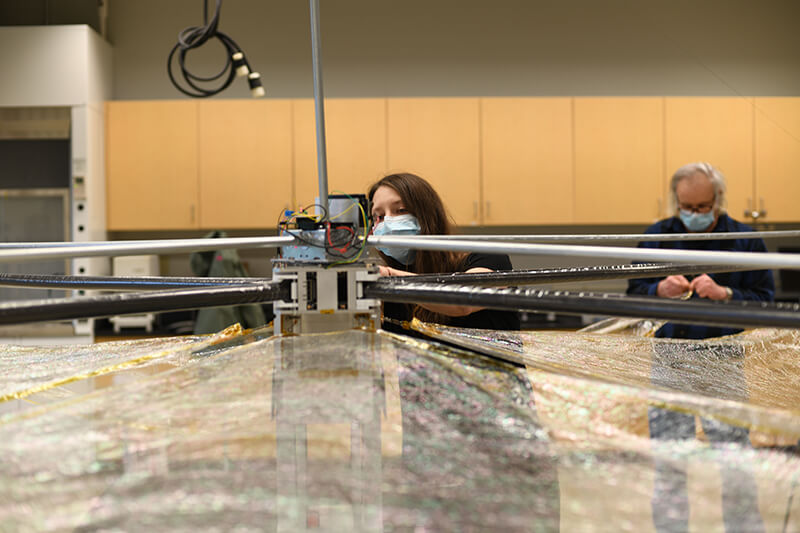August 31, 2021
Spacecraft deorbiting device developed at Purdue ready for upcoming test launch
UPDATE: The unmanned rocket carrying this drag sail exploded shortly after launch on Sept. 2.
WEST LAFAYETTE, Ind. — A drag sail that a team at Purdue University developed to pull launch vehicles in space back to Earth is scheduled to undergo a test launch on Thursday (Sept. 2).
The mission, set to take off from Vandenberg Space Force Base in California, will evaluate how well the prototype helps its vehicle deorbit from space after mission completion. A livestream of the launch will be available through Everyday Astronaut.
Faster deorbiting times may prevent spacecraft and launch vehicles from turning into hazardous space debris as they wait to deorbit naturally, a process that could take days, months or years without assistance. Abandoned, lost or post-mission space vehicles are part of the more than nine thousand tons of space debris currently traveling through Earth’s lower orbit at dangerous speeds.
Deorbiting technology is a preventive approach to managing the growth of space debris, an issue NASA has acknowledged as essential to the future of safe space exploration.
Named the Spinnaker3, the drag sail will be riding on a rocket from Firefly Aerospace along with six other prototypes for testing. The launch is a part of Firefly’s DREAM Mission, carrying educational payloads into orbit.
 Purdue Ph.D. candidate Arly Black (front) and lab engineer Anthony Cofer test sail deployment for Spinnaker3. (Purdue University photo/David Spencer)
Download image
Purdue Ph.D. candidate Arly Black (front) and lab engineer Anthony Cofer test sail deployment for Spinnaker3. (Purdue University photo/David Spencer)
Download image
The plan is for the drag sail to specifically deorbit the upper stage of the Firefly launch vehicle. Developers expect the Spinnaker3 to reduce the vehicle’s upper stage deorbiting process from 25 to 15 days.
The drag sail was produced by a team of students, faculty and staff at Purdue’s Space Flight Projects Laboratory. The team dedicated a year to design and development, and lab testing was completed in the spring. Development took place under the direction of David Spencer, a Purdue adjunct associate professor of aeronautics and astronautics.
Spencer is also mission manager for the Mars Sample Return Campaign at NASA’s Jet Propulsion Laboratory in California and founder of Vestigo Aerospace LLC, a startup company producing a full line of Spinnaker drag sail prototypes for different sizes of space vehicles. The Purdue Research Foundation licenses the technology, and Spencer has worked with the Purdue Foundry on business model development for the startup.
The Spinnaker3, named for the three-meter length of its carbon-fiber booms, rides on the exterior of the launch vehicle upper stage. The booms were provided by NASA Langley Research Center under a NASA Space Act Agreement with Purdue. California Polytechnic State University, San Luis Obispo provided avionics for the Spinnaker3 payload and assisted with testing and installation of Spinnaker3 on the Firefly rocket.
The sail will deploy at the end of the rocket’s mission and use atmospheric drag to assist with the deorbiting process. At full deployment, the sail is 194 square feet and is made of CP1, a fluorinated polyimide developed by high-performance materials designer NeXolve. An animation of the sail deployment is available online.
Images of the drag sail while it is in space will be captured by a camera mounted on the Firefly launch vehicle upper stage. The vehicle’s deorbit timeline will be evaluated based upon tracking data provided the United States Space Command.
More details about the launch are available here.
About Purdue University
Purdue University is a top public research institution developing practical solutions to today’s toughest challenges. Ranked the No. 5 Most Innovative University in the United States by U.S. News & World Report, Purdue delivers world-changing research and out-of-this-world discovery. Committed to hands-on and online, real-world learning, Purdue offers a transformative education to all. Committed to affordability and accessibility, Purdue has frozen tuition and most fees at 2012-13 levels, enabling more students than ever to graduate debt-free. See how Purdue never stops in the persistent pursuit of the next giant leap at https://purdue.edu/.
Media contact: Kayla Wiles, 765-494-2432, wiles5@purdue.edu
Writer: Christy McCarter
Sources: David Spencer, Purdue adjunct associate professor of aeronautics and astronautics
Anthony Cofer, Purdue spacecraft laboratory manager
Arly Black, Purdue Ph.D. candidate in aeronautics and astronautics
Note to journalists: An animation showing the drag sail attached to a launch vehicle in space is available on YouTube. The YouTube video files, photos of researchers working on the drag sail, and drone views of the drag sail are available in a Google Drive folder. Journalists visiting campus should follow visitor health guidelines.

